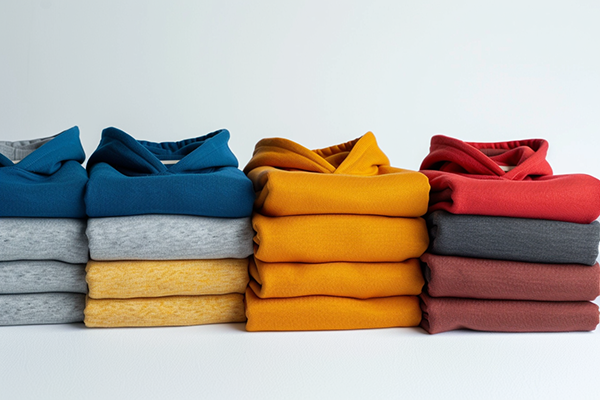A hoodie is more than just a casual garment; it’s a staple in many wardrobes, loved for its comfort, versatility, and style. However, the fabric used in a hoodie plays a significant role in determining its quality. Whether you’re looking for warmth, durability, or softness, choosing the right material is key.
The best quality fabric for hoodies depends on the purpose of the garment. Cotton offers unmatched comfort1, polyester provides durability and moisture resistance, and blends combine the best of both worlds.
In this article, we’ll explore the highest-quality hoodie materials, the importance of GSM in fabric quality, and what a 100% polyester hoodie feels like.
What is the highest quality hoodie material?
The material of a hoodie directly impacts its comfort, durability, and suitability for different occasions.
The highest quality hoodie materials include cotton, cotton-polyester blends, and fleece, with each offering distinct advantages based on your needs.

1. Cotton
-
Why It’s High-Quality:
- Cotton is soft, breathable, and hypoallergenic, making it ideal for everyday wear.
- It provides a natural feel and absorbs moisture, which adds to its comfort.
-
Best For:
- Casual hoodies for lounging or mild weather.
-
Drawbacks:
- 100% cotton hoodies can shrink in the wash and are less durable than synthetic fabrics.
2. Cotton-Polyester Blends
-
Why It’s High-Quality:
- Blends combine the softness of cotton with the durability and wrinkle resistance of polyester.
- They are less prone to shrinking and provide better moisture-wicking than pure cotton.
-
Best For:
- Versatile hoodies for casual wear, athletic activities, or layering.
3. Fleece
-
Why It’s High-Quality:
- Fleece (made from polyester) is lightweight yet warm, perfect for cold weather.
- Brushed fleece provides a soft, cozy interior.
-
Best For:
- Hoodies designed for winter or outdoor activities.
4. French Terry2
-
Why It’s High-Quality:
- French terry is a looped fabric that’s breathable and moisture-wicking.
- It’s lighter than fleece, making it suitable for transitional seasons.
-
Best For:
- Hoodies for spring and fall or lightweight layering.
| Material | Key Benefits | Best Use |
|---|---|---|
| Cotton | Soft, breathable, natural | Casual wear, mild weather |
| Cotton-Polyester Blends | Durable, wrinkle-resistant, moisture-wicking | Everyday wear, athletic use |
| Fleece | Warm, lightweight, cozy | Winter or outdoor hoodies |
| French Terry | Breathable, moisture-wicking | Spring and fall hoodies |
Choosing the right material ensures that your hoodie fits your comfort and functionality needs.
What is the best GSM quality for hoodies?
GSM (grams per square meter3) is a measurement of fabric weight, which helps determine the thickness and durability of a hoodie.
The best GSM for hoodies ranges from 280 GSM to 400 GSM, depending on the desired thickness and intended use. Higher GSM fabrics are thicker and warmer, while lower GSM options are lightweight and breathable.

GSM and Hoodie Quality
-
Lightweight Hoodies (200–280 GSM)
- Features: Thin, breathable fabric suitable for warmer climates or layering.
- Best For: Athletic hoodies, spring/summer wear.
-
Midweight Hoodies (280–350 GSM)
- Features: Balanced weight that offers warmth without being too bulky.
- Best For: Everyday hoodies or year-round use.
-
Heavyweight Hoodies (350–400+ GSM)
- Features: Thick fabric for maximum warmth and durability.
- Best For: Winter hoodies or premium-quality sweatshirts.
How GSM Affects Comfort and Durability
- High GSM: Thicker fabric is more durable, retains heat better, and feels luxurious.
- Low GSM: Lightweight fabric is more breathable and suited for activewear or mild climates.
| GSM Range | Characteristics | Ideal Use |
|---|---|---|
| 200–280 GSM | Lightweight, breathable | Spring/summer, athletic wear |
| 280–350 GSM | Midweight, versatile | Year-round casual wear |
| 350–400+ GSM | Heavyweight, warm | Winter hoodies, premium options |
When choosing a hoodie, consider its GSM to match the fabric’s weight with your intended use and climate.
What does a 100% polyester hoodie feel like?
Polyester is one of the most widely used fabrics in hoodies due to its durability and moisture resistance. But what does it feel like to wear?
A 100% polyester hoodie feels smooth, lightweight, and slightly synthetic, offering durability and moisture-wicking properties. However, it lacks the softness and natural feel of cotton.

Key Features of 100% Polyester Hoodies
-
Texture
- Polyester has a smooth, almost slippery texture.
- Modern manufacturing techniques have improved polyester’s softness4, making it more comfortable.
-
Breathability
- While not as breathable as cotton, polyester hoodies often incorporate mesh panels or moisture-wicking technology to enhance airflow.
-
Warmth and Insulation
- Polyester is not inherently warm but retains heat well when combined with fleece or other insulating materials.
-
Durability
- Resistant to wrinkles, shrinking, and stretching.
- Ideal for activewear or outdoor use.
-
Moisture-Wicking
- Polyester wicks sweat away from the body, keeping you dry during exercise.
Pros and Cons of 100% Polyester Hoodies
| Pros | Cons |
|---|---|
| Durable and long-lasting | Lacks the natural softness of cotton |
| Wrinkle-resistant | May feel synthetic to some wearers |
| Moisture-wicking | Less breathable than cotton |
| Lightweight | Retains odors more easily |
A 100% polyester hoodie is an excellent choice for athletic or performance-focused wear, but for casual comfort, blended fabrics might be more appealing.
Conclusion
The best quality fabric for hoodies depends on your needs, whether it’s softness, durability, or warmth. Cotton offers natural comfort1, while cotton-polyester blends provide the perfect balance of durability and softness. Fleece and French terry are excellent for seasonal versatility, and GSM measurements help determine the hoodie’s weight and quality. A 100% polyester hoodie excels in performance and durability, making it a favorite for activewear. By understanding these fabric characteristics5, you can choose the perfect hoodie for any occasion.













